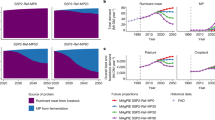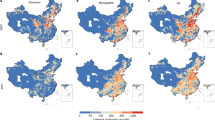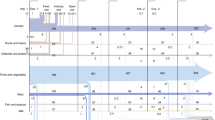Abstract
Nearly half of global pork production and consumption occurs in China, but the transition towards intensification is associated with worsening environmental impacts. Here we explore scenarios for implementing structural and technological changes across the pork supply chain to improve environmental sustainability and meet future demand. Following the middle-of-the-road socio-economic pathway (SSP2), we estimate that the environmental footprint from the pork supply chain will increase by ~50% from 2017 to 2050. Utilizing technologies that improve feed crop production and manure management could reduce phosphorus and nitrogen losses by three-quarters and one-third, respectively, with modest reductions in greenhouse gas emissions and cropland area. Reducing pork consumption had substantial mitigation potential. Increased feed and pork imports would decrease domestic environmental footprints and meet demand, but increase footprints elsewhere. We conclude that farm-specific technologies and structural adjustments can support the development of rural, small-scale pig farms near cropland and promote circular economy principles.
This is a preview of subscription content, access via your institution
Access options
Access Nature and 54 other Nature Portfolio journals
Get Nature+, our best-value online-access subscription
$29.99 / 30 days
cancel any time
Subscribe to this journal
Receive 12 digital issues and online access to articles
$119.00 per year
only $9.92 per issue
Buy this article
- Purchase on Springer Link
- Instant access to full article PDF
Prices may be subject to local taxes which are calculated during checkout





Similar content being viewed by others
Data availability
Data supporting the findings of this study are available within the article and its Supplementary Information files, or are available from the corresponding author upon reasonable request.
Code availability
The statistical coding is available from the corresponding author on reasonable request.
References
FAOSTAT 2020. FAO http://faostat.fao.org/ (2020).
Ministry of Agriculture and Rural Affairs of the People’s Republic of China. China Animal Husbandry and Veterinary Yearbook (China Agriculture Press, 2018).
Bai, Z. et al. Changes in pig production in China and their effects on nitrogen and phosphorus use and losses. Environ. Sci. Technol. 48, 12742–12749 (2014).
Long, W. et al. Mitigation of multiple environmental footprints for China’s pig production using different land use strategies. Environ. Sci. Technol. 55, 4440–4451 (2021).
Richard, F. et al. US–China trade war imperils Amazon rainforest. Nature 567, 451–454 (2019).
Wang, L. Modern Chinese Pig Production (Jindun Press, 2007).
Stylianou, K. et al. Small targeted dietary changes can yield substantial gains for human health and the environment. Nat. Food 2, 616–627 (2021).
Herrero, M. et al. Greenhouse gas mitigation potentials in the livestock sector. Nat. Clim. Chang. 6, 452–461 (2016).
Havlík, P. et al. Climate change mitigation through livestock system transitions. Proc. Natl Acad. Sci. USA 111, 3709–3714 (2014).
Du, Y. et al. A global strategy to mitigate the environmental impact of China’s ruminant consumption boom. Nat. Commun. 9, 4133 (2018).
Bai, Z. et al. Relocate 10 billion livestock to reduce harmful nitrogen pollution exposure for 90% of China’s population. Nat. Food 3, 152–160 (2022).
Gu, B. Recoupling livestock and crops. Nat. Food 3, 102–103 (2022).
Jin, S. et al. Decoupling livestock and crop production at the household level in China. Nat. Sustain. 4, 48–55 (2021).
Muscat, A. et al. Principles, drivers and opportunities of a circular bioeconomy. Nat. Food 2, 561–566 (2021).
Uwizeye, A. et al. Nitrogen flows in global pork supply chains and potential improvement from feeding swill to pigs. Resour. Conserv. Recycl. 146, 168–179 (2019).
Bai, Z. et al. China’s livestock transition: driving forces, impacts, and consequences. Sci. Adv. 4, r8534 (2018b).
Wang, H. et al. Can dietary manipulations improve the productivity of pigs with lower environmental and economic cost? A global meta-analysis. Agr. Ecosyst. Environ. 289, 106748 (2020).
O’Neill, B.C. et al. Meeting report of the workshop on the nature and use of new socioeconomic pathways for climate change research. Clim. Change 122, 387–400 (2014).
Chinese Nutrition Society. Dietary Guidelines for Chinese Residents (People’s Medical Publishing House, 2022).
Zhao, J. et al. China needs long-term solutions for African swine fever. Sci. Bull. 64, 1469–1471 (2019).
Xu, Z. et al. Impacts of international trade on global sustainable development. Nat. Sustain. 3, 964–971 (2020).
Yao, G. et al. The increasing global environmental consequences of a weakening US–China crop trade relationship. Nat. Food 8, 578–586 (2021).
He, P. et al. Environmental impacts of dietary quality improvement in China. J. Environ. Manag. 240, 518–526 (2019).
Tukker, A. et al. Environmental and resource footprints in a global context: Europe’s structural deficit in resource endowments. Glob. Environ. Chang. 40, 171–181 (2016).
FAO. Food-based dietary guidelines 2022. FAO https://www.fao.org/nutrition/education/food-dietary-guidelines/en/ (2022).
Lassaletta, L. et al. Future global pig production systems according to the Shared Socioeconomic Pathways. Sci. Total Environ. 665, 739–751 (2019).
FAO. The future of food and agriculture—alternative pathways to 2050. FAO https://www.fao.org/global-perspectives-studies/resources (2018).
Chaudhary, A. & Krishna, V. Country-specific sustainable diets using optimization algorithm. Environ. Sci. Technol. 53, 7694–7703 (2019).
Komarek, A. M. et al. Income, consumer preferences, and the future of livestock-derived food demand. Glob. Environ. Chang. 70, 102343 (2021).
Zhang, S. et al. Pork production systems in China: a review of their development, challenges and prospects in green production. Front. Agr. Sci. Eng. 8, 15–24 (2021).
National Bureau of Statistics of the People’s Republic of China. China Statistical Yearbook (China Statistics Press, 2018).
Wei, S. et al. Environmental, economic and social analysis of peri-urban pig production. J. Clean. Prod. 129, 596–607 (2016).
Tan, M. X. et al. Operational costs and neglect of end-users are the main barriers to improving manure treatment in intensive livestock farms. J. Clean. Prod. 289, 125149 (2021).
Chadwick, D. et al. Improving manure nutrient management towards sustainable agricultural intensification in China. Agr. Ecosyst. Environ. 209, 34–46 (2015).
Zhu, Z. et al. Integrated livestock sector nitrogen pollution abatement measures could generate net benefits for human and ecosystem health in China. Nat. Food 3, 161–168 (2022).
Zhang, X. et al. Societal benefits of halving agricultural ammonia emissions in China far exceed the abatement costs. Nat. Commun. 11, 4357 (2020).
Lacoste, M. et al. On-farm experimentation to transform global agriculture. Nat. Food 3, 11–18 (2022).
Zhang, N. et al. Reducing ammonia emissions from dairy cattle production via cost-effective manure management techniques in China. Environ. Sci. Technol. 53, 11840–11848 (2019).
Fan, L. et al. Decreasing farm number benefits the mitigation of agricultural non-point source pollution in China. Environ. Sci. Pollut. 26, 464–472 (2018).
Herrero, M. et al. Livestock, livelihoods and the environment: understanding the trade-offs. Curr. Opin. Environ. Sustain. 1, 111–120 (2009).
Mottet, A. et al. Livestock: on our plates or eating at our table? A new analysis of the feed/food debate. Glob. Food Secur. 14, 1–8 (2017).
Jin, X. et al. Nitrogen budgets of contrasting crop-livestock systems in China. Environ.Pollut. 288, 117633 (2021).
Zhang, X. et al. Benefits and trade‐offs of replacing synthetic fertilizers by animal manures in crop production in China: a meta‐analysis. Glob. Change Biol. 26, 888–900 (2019).
Xue, L. et al. China’s food loss and waste embodies increasing environmental impacts. Nat. Food 2, 519–528 (2021).
Willett, W. et al. Food in the Anthropocene: the EAT–Lancet Commission on healthy diets from sustainable food systems. Lancet 393, 447–492 (2019).
Gan, M. et al. High altitude adaptability and meat quality in Tibetan pigs: a reference for local pork processing and genetic improvement. Animals 9, 1080 (2019).
Allen, T. et al. Global hotspots and correlates of emerging zoonotic diseases. Nat. Commun. 8, 1124 (2017).
IPCC. IPCC Guidelines for National Greenhouse Gas Inventories. In Agriculture, Forestry and Other Land Use Vol. 4 (2006).
Lei, A. et al. The nitrogen footprint of food products in the European Union. J. Agr. Sci. 152, 20–33 (2014).
Günther, J. et al. Carbon and phosphorus footprint of the cotton production in Xinjiang, China, in comparison to an alternative fibre (Apocynum) from Central Asia. J. Clean. Prod. 148, 490–497 (2017).
National Development and Reform Commission of the People’s Republic of China. National Cost–Benefit Compilation of Agricultural Products (China Statistics Press, 2018).
Mason-D’Croz, D. et al. Modelling the global economic consequences of a major African swine fever outbreak in China. Nat. Food 1, 221–228 (2020).
Herrero, M. & Thornton, P. K. Livestock and global change: emerging issues for sustainable food systems. Proc. Natl Acad. Sci. USA 110, 20878–20881 (2013).
Chen, X. P. et al. Integrated soil-crop system management for food security. Proc. Natl Acad. Sci. USA 108, 6399–6404 (2011).
Chen, X. P. et al. Producing more grain with lower environmental costs. Nature 514, 486–489 (2014).
Xia, L. et al. Can knowledge-based N management produce more staple grain with lower greenhouse gas emission and reactive nitrogen pollution? A meta-analysis. Glob. Change Biol. 23, 1917–1925 (2017).
Chen, D. Nutrition and feed strategies for sustainable swine production in China. Fron. Agric. China 3, 471–477 (2009).
Reckmann, K., Traulsen, I. & Krieter, J. Life cycle assessment of pork production: a data inventory for the case of Germany. Livest. Sci. 157, 586–596 (2013).
Hou, Y., Velthof, G. L. & Oenema, O. Mitigation of ammonia, nitrous oxide and methane emissions from manure management chains: a meta-analysis and integrated assessment. Glob. Change Biol. 21, 1293–1312 (2015).
Hou, Y. et al. Nutrient recovery and emissions of ammonia, nitrous oxide, and methane from animal manure in Europe: effects of manure treatment technologies. Environ. Sci. Technol. 51, 375–383 (2017).
Wang, Y. et al. Mitigating greenhouse gas and ammonia emissions from swine manure management: a system analysis. Environ. Sci. Technol. 51, 4503–4511 (2017).
Ma, L. et al. Modeling nutrient flows in the food chain of China. J. Environ. Qual. 39, 1279–1289 (2010).
Acknowledgements
This work was supported by the National Natural Science Foundation of China (NSFC, grant no. 31772393 to Y.H.), the National Key R&D Program of China funded by the Ministry of Science and Technology of the People’s Republic of China (MOST, grant no. 2016YFE0103100 to Y.H.), the Program of Advanced Discipline Construction in Beijing (Agriculture Green Development to Y.H. and B.T.), the High-level Team Project of China Agricultural University (CAU to Y.H.) and Agriculture Green Development Program sponsored by China Scholarship Council and Hainan University (no. 201913043 to L.Z. and W.L.).
Author information
Authors and Affiliations
Contributions
B.T., L.Z., Y.H. and O.O. designed the research; B.T., L.Z. and W.L. developed the model; B.T., L.Z., Y.H. and O.O. analysed data; B.T., L.Z., Y.H., O.O., G.V., W.M. and F.Z. wrote the paper. All authors contributed to analysis of the results. All authors read and commented on various drafts of the paper.
Corresponding author
Ethics declarations
Competing interests
The authors declare no competing interests.
Peer review
Peer review information
Nature Food thanks Hongmin Dong, Aimable Uwizeye and the other, anonymous, reviewer(s) for their contribution to the peer review of this work.
Additional information
Publisher’s note Springer Nature remains neutral with regard to jurisdictional claims in published maps and institutional affiliations.
Supplementary information
Supplementary Information
Supplementary Figs. 1–6, discussion and Tables 1–23.
Source data
Source Data Fig. 1
Model estimation.
Source Data Fig. 2
Model estimation.
Source Data Fig. 3
Model estimation.
Rights and permissions
Springer Nature or its licensor (e.g. a society or other partner) holds exclusive rights to this article under a publishing agreement with the author(s) or other rightsholder(s); author self-archiving of the accepted manuscript version of this article is solely governed by the terms of such publishing agreement and applicable law.
About this article
Cite this article
Tong, B., Zhang, L., Hou, Y. et al. Lower pork consumption and technological change in feed production can reduce the pork supply chain environmental footprint in China. Nat Food 4, 74–83 (2023). https://doi.org/10.1038/s43016-022-00640-6
Received:
Accepted:
Published:
Issue Date:
DOI: https://doi.org/10.1038/s43016-022-00640-6



